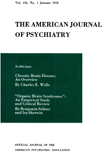ANALYSIS OF 1955-1956 POPULATION FALL IN NEW YORK STATE MENTAL HOSPITALS IN FIRST YEAR OF LARGE-SCALE USE OF TRANQUILIZING DRUGS
Abstract
In the year 1955-56 the number of patients reached by somatic therapy in the mental hospitals of New York State was increased by some 250% due to the introduction of the tranquilizing drugs, chlorpromazine and reserpine. At the end of that year the residual population of the state hospitals showed a fall of some 500 patients in comparison with the increase of 2,500 of the year before and the average rise of 2,000 per year for the previous decade. More recently, figures have become available, indicating that similar changes have occurred very widely elsewhere. In New York the same trend continued during 1956-57, producing a further reduction of some 500. Going on the assumption that the cause of the fall of population might be reflected to some degree in the distribution of the sudden population change, we carried out an analysis which compared the over-all data for 1955-56 with that for the previous year. No difference in hospital procedure or method was identified except the addition of drug therapy on a large scale in 1955-56.
In addition to comparing 1954-55 with 1955-56, we also compared the recent population fall with that which occurred during World War II.
From this work the following conclusions are drawn:
1. A major identifiable influence in the present trend toward stabilization of New York State mental hospital population is the large-scale use of tranquilizing drugs, of which chlorpromazine now constitutes about 75%.
2. In addition, there appears to be a weaker influence of nonspecific distribution operating in the state school population and in categories of mental hospital patients where the drugs have only a restricted and symptomatic indication. These categories are still continuing their long-term increase but the rate of growth has diminished.
3. The 1955-56 improvement was distributed as might be expected from clinical experience with drugs. It was relatively greater among functional cases and cases of longer hospital stay, especially schizophrenics.
4. The present fall of state hospital population in New York differs basically from the 1942-43 reduction in: (1) the suddenness of its development, (2) the fact that hospital admissions remained high, (3) its involving primarily a fall in the residual schizophrenic population while the war-time change involved all categories in a diffuse fashion.
5. In spite of a marked increase in releases following large-scale drug therapy, the rate of return was slightly less than before.
6. One of the most outstanding values of the use of tranquilizing drugs in mental institutions is reflected in the data on restraint and seclusion. In two year's time these figures were reduced by 75% . This is only a mathematical expression of what has been a revolution in the care and treatment of mental patients.
7. Our figures do not support the thesis that we are at a point where we can expect a large-scale reduction of need for mental hospital beds. There is reason to believe that a downward change in the economic level might very well have such a large negative effect as to produce again an increase of hospital population unless even more effective treatment methods are developed.
Access content
To read the fulltext, please use one of the options below to sign in or purchase access.- Personal login
- Institutional Login
- Sign in via OpenAthens
- Register for access
-
Please login/register if you wish to pair your device and check access availability.
Not a subscriber?
PsychiatryOnline subscription options offer access to the DSM-5 library, books, journals, CME, and patient resources. This all-in-one virtual library provides psychiatrists and mental health professionals with key resources for diagnosis, treatment, research, and professional development.
Need more help? PsychiatryOnline Customer Service may be reached by emailing [email protected] or by calling 800-368-5777 (in the U.S.) or 703-907-7322 (outside the U.S.).



